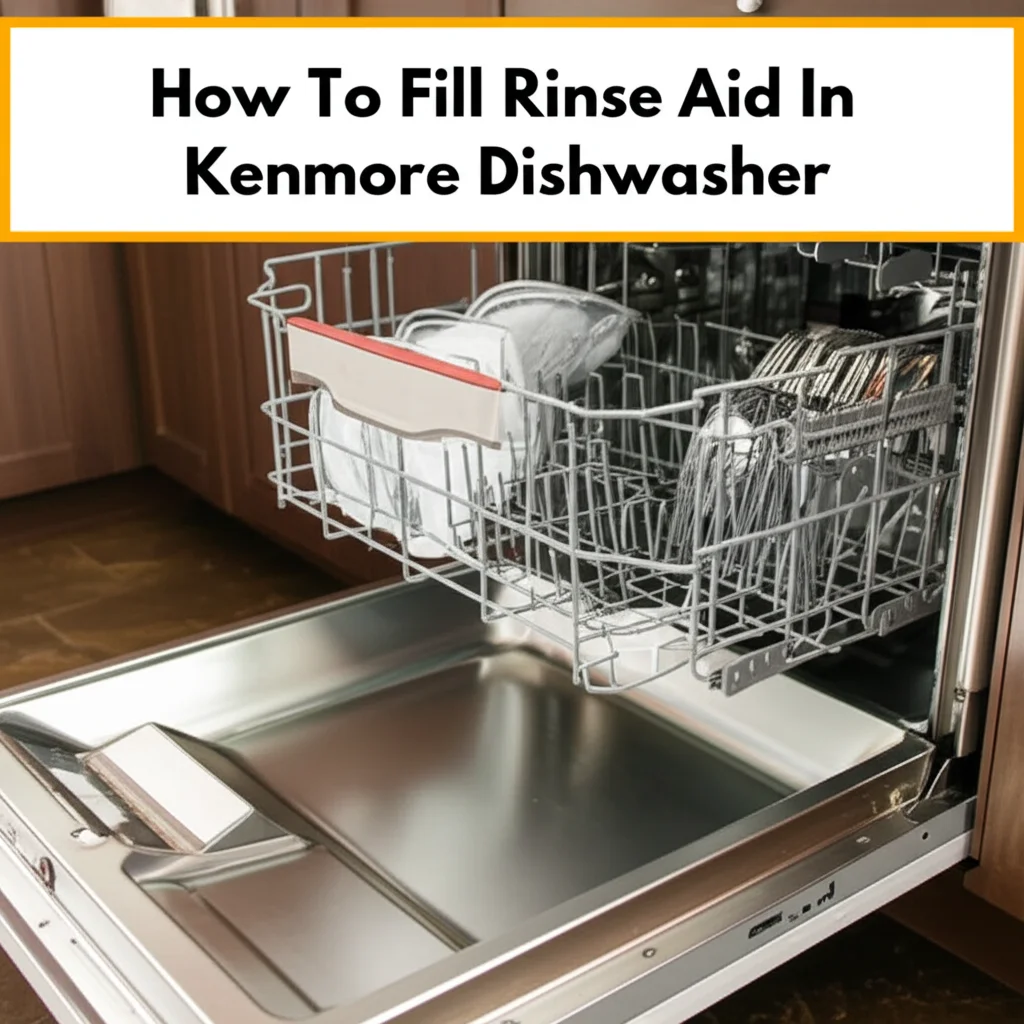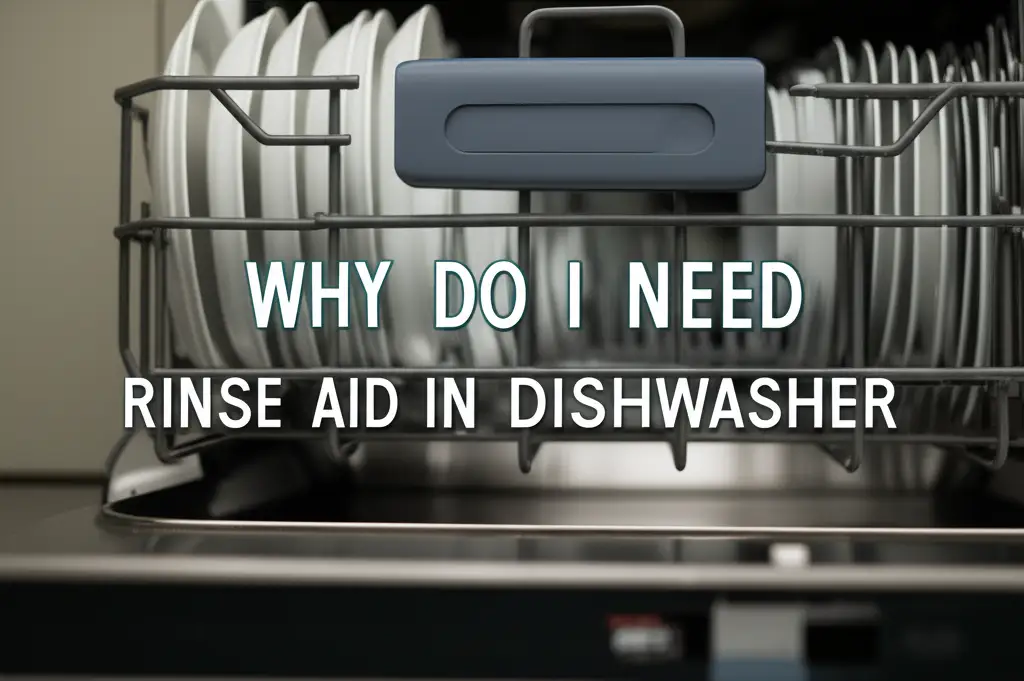· Todd Martin · Kitchen Appliances · 15 min read
How To Fill Rinse Aid In Kenmore Dishwasher

Fill Rinse Aid in Your Kenmore Dishwasher for Spotless Results
Imagine sparkling clean dishes without water spots or streaks. Many people desire this outcome from their dishwasher. My Kenmore dishwasher usually delivers excellent results, but sometimes, dishes come out with noticeable marks. This often happens because of hard water or the absence of a simple but vital ingredient: rinse aid.
Rinse aid is a liquid agent that helps water sheet off dishes during the final rinse cycle. This prevents water droplets from drying on surfaces, which leaves unsightly spots and streaks. For Kenmore dishwasher owners, using rinse aid is a key step to achieve truly spotless glassware and dinnerware. This guide will show you precisely how to fill rinse aid in your Kenmore dishwasher. We will cover finding the dispenser, the filling process, and tips for best performance.
Takeaway
- Rinse aid is crucial for spot-free, streak-free dishes in your Kenmore dishwasher.
- Locate the rinse aid dispenser near the detergent dispenser inside the dishwasher door.
- Open the cap, pour rinse aid until the indicator shows full, and close the cap securely.
- Regularly check and refill the rinse aid dispenser to maintain optimal drying performance.
To fill rinse aid in a Kenmore dishwasher, locate the circular or square dispenser compartment on the inner door, often next to the detergent dispenser. Twist or pull open the cap. Pour liquid rinse aid into the opening until the indicator shows “Full.” Do not overfill. Close the cap firmly to prevent leaks during the wash cycle.
Understanding Rinse Aid: Why Your Kenmore Needs It
Rinse aid plays a vital role in achieving clean, dry dishes from your Kenmore dishwasher. Many people think detergent alone is enough for sparkling results. However, rinse aid addresses a different part of the cleaning process: drying. It helps remove water from your dishes.
Water, especially hard water, contains minerals. These minerals remain on dish surfaces when water dries slowly, causing spots and streaks. This is very common for glasses and silverware. Rinse aid changes the surface tension of water. It makes water sheet off dishes quickly. This action helps water drain away before it can leave mineral deposits. My own experience shows a clear difference when I use rinse aid regularly. My glassware comes out shiny, not cloudy.
For your Kenmore dishwasher, using rinse aid means more than just appearance. It also helps your dishwasher work more efficiently. When dishes dry better, you reduce the need for hand-drying. This saves time and effort. It also prevents moisture buildup inside the dishwasher, which can contribute to odors or even mold over time. Proper dishwasher care includes using rinse aid for optimal performance and hygiene. You can also explore how to clean the inside of a dishwasher to ensure overall cleanliness.
Rinse aid also works well with modern dishwasher detergents. Many detergents now focus on cleaning power. Rinse aid picks up the slack for drying and spot prevention. It ensures every cycle delivers the best possible results. This combination provides a complete wash experience.
Locating the Rinse Aid Dispenser in Your Kenmore Dishwasher
Finding the rinse aid dispenser in your Kenmore dishwasher is straightforward. It is usually located on the inside of the dishwasher door. You will find it near the main detergent dispenser. This design is standard across most Kenmore models.
The rinse aid dispenser typically has a distinct appearance. It might be a circular cap or a small, square-shaped door. Look for labels like “Rinse Aid,” “Rinse,” or a starburst symbol. This symbol often indicates the rinse aid compartment. On some Kenmore dishwashers, you might see a small clear window or an indicator light. This shows the rinse aid level. My Kenmore has a small window that changes color when the rinse aid is low. This feature is very helpful.
Opening the dispenser varies slightly by model. Some caps twist counter-clockwise to unlock and remove. Others might have a small latch or button you press to release the cover. Once you open it, you will see a small reservoir inside. This is where you pour the liquid rinse aid. Make sure you can easily access this area. If you find your dishwasher needs a general cleaning, you might want to look into how to clean a dishwasher how to deep for a thorough cleaning.
Always refer to your specific Kenmore dishwasher’s owner’s manual if you have trouble. The manual provides exact instructions and diagrams for your model. It can help you identify the precise location and opening method. Knowing where the dispenser is, makes refilling simple and quick.
Step-by-Step Guide: How to Fill Rinse Aid in Kenmore Dishwasher
Filling the rinse aid in your Kenmore dishwasher is a simple process. Follow these steps for successful refilling and spot-free dishes. I find that doing this regularly ensures my dishes always look their best.
- Open the Dishwasher Door: Start by fully opening your Kenmore dishwasher door. This gives you easy access to the dispenser. Make sure the racks are clear and not blocking the dispenser area.
- Locate the Rinse Aid Dispenser: As discussed, find the rinse aid compartment. It’s on the inner door, usually next to the detergent dispenser. Look for the “Rinse Aid” label or the starburst symbol.
- Open the Dispenser Cap: Most Kenmore rinse aid dispensers have a twist-off cap or a latch. Twist the cap counter-clockwise to remove it. If it has a latch, press or lift it to open the dispenser door.
- Pour the Rinse Aid: Carefully pour the liquid rinse aid into the dispenser opening. Pour slowly to avoid spills. Many dispensers have a fill line or “MAX” indicator. Fill the compartment only up to this line. Do not overfill. Overfilling can cause excess suds or leaks during the wash cycle.
- Close the Dispenser Cap Securely: Once filled, firmly replace the cap. Twist it clockwise until it clicks or locks into place. If it’s a latch-style door, push it shut until it clicks securely. A tight seal prevents the rinse aid from leaking out too early during the wash cycle.
- Wipe Up Spills (Optional but Recommended): If any rinse aid spills onto the dishwasher door or inside, wipe it immediately with a damp cloth. Spilled rinse aid can cause excessive suds if it mixes with the detergent in the main wash cycle. This can affect dishwasher performance.
You have now successfully refilled your Kenmore dishwasher’s rinse aid dispenser. You are ready for many cycles of sparkling clean dishes. Regular refilling ensures consistent results.
Choosing the Best Rinse Aid for Your Kenmore Dishwasher
Selecting the right rinse aid for your Kenmore dishwasher is important for optimal performance. While many brands are available, understanding the types and features can help you make an informed choice. I have tried several brands, and some perform better than others.
The most common type is liquid rinse aid. These are designed to be poured directly into your dishwasher’s dispenser. Popular brands include Finish Jet-Dry, Cascade Platinum Rinse Aid, and store-brand options. Most liquid rinse aids work well with Kenmore dishwashers. They are formulated to be compatible with standard dishwasher materials and cycles. My Kenmore manual simply recommends “automatic dishwasher rinse aid,” allowing for flexibility in brand choice.
Some dishwasher detergents now include rinse aid within their formulation. These are often labeled as “all-in-one” or “pods with rinse aid.” While convenient, they may not provide the same level of spot prevention as a dedicated liquid rinse aid. If you have hard water or consistently notice spots, a separate liquid rinse aid is usually more effective. It allows for a controlled dosage.
When choosing a rinse aid, consider your local water hardness. If you have very hard water, you might benefit from a rinse aid specifically designed for hard water conditions. These often contain extra agents to combat mineral deposits more aggressively. You can usually find information about your water hardness from your local water utility.
Most Kenmore dishwashers allow you to adjust the rinse aid dosage. This setting controls how much rinse aid dispenses per cycle. If you notice too many suds or a residue, you might reduce the dosage. If dishes are still spotty, increase it. Check your Kenmore owner’s manual for instructions on adjusting this setting. This customization helps you fine-tune your dishwasher’s performance.
Optimizing Kenmore Dishwasher Performance with Rinse Aid
Proper rinse aid use is key to getting the best results from your Kenmore dishwasher. It goes beyond just filling the dispenser. Optimizing its use involves understanding how it works with your specific conditions. I have learned through trial and error how to get my dishes perfectly clean.
First, always ensure the rinse aid dispenser is adequately filled. Most Kenmore models have an indicator light or a clear window that signals when the rinse aid level is low. Pay attention to these alerts. Running a cycle without sufficient rinse aid, especially with hard water, will result in water spots. The frequency of refilling depends on how often you run your dishwasher and the rinse aid dosage setting. For a household running the dishwasher daily, refilling might be needed once a month or every few weeks.
Water hardness significantly impacts rinse aid effectiveness. Hard water leaves more mineral deposits. If you live in an area with hard water, you might need a higher rinse aid dosage. Your Kenmore dishwasher typically has adjustable settings for rinse aid release. Consult your owner’s manual to find out how to increase the dosage if your dishes are still spotty. Conversely, if you notice a blueish film or excessive suds, you might be using too much. Reduce the dosage.
Consider other aspects of your dishwasher’s performance. A clogged filter or dirty spray arms can hinder effective rinsing, even with rinse aid. Regularly cleaning your dishwasher’s filter is essential. You can learn how to clean filter in dishwasher to improve overall cleaning. If your dishes are still not sparkling, check for blocked spray arm holes. Make sure they are clear for proper water distribution.
Sometimes, issues like detergent residue or cloudiness are mistaken for rinse aid problems. Ensure you use the correct amount of detergent for your water hardness and load size. Overdosing detergent can leave a film. Using high-quality detergent also helps. By combining proper rinse aid use with overall good dishwasher maintenance, your Kenmore will consistently deliver spotless, dry dishes.
Common Mistakes to Avoid When Filling Kenmore Dishwasher Rinse Aid
Even a simple task like filling rinse aid can lead to common mistakes. Avoiding these errors ensures your Kenmore dishwasher performs at its best. I have made a few of these mistakes myself, leading to less-than-perfect results.
One common mistake is overfilling the rinse aid dispenser. When you pour rinse aid beyond the “MAX” line, it can lead to excess foam in the dishwasher. This foam might spill out during the wash cycle. It can also leave a streaky residue on your dishes. Always fill only to the indicated line. If you accidentally overfill, simply wipe up the excess with a damp cloth.
Another mistake is using the wrong liquid in the rinse aid compartment. The rinse aid dispenser is designed only for liquid rinse aid. Never put liquid dish soap or powdered detergent into this compartment. These products will cause massive sudsing during the wash cycle. This can lead to overflows and damage your dishwasher. Always double-check the product you are pouring.
Ignoring the rinse aid indicator light or window is also a frequent oversight. Kenmore dishwashers have these indicators for a reason. They tell you when the rinse aid level is low. If you wait until your dishes are consistently spotty before refilling, you are missing out on optimal performance. Make it a habit to check the indicator every few washes.
Some people try to use vinegar as a substitute for rinse aid. While vinegar can help with some hard water issues, it is not a true substitute for commercial rinse aid. Vinegar is acidic and can, over time, degrade rubber seals and certain plastic components in your dishwasher. It may also leave a strong odor. For dedicated cleaning, you can learn how to clean dishwasher with vinegar. However, for rinse aid, it is best to stick to products specifically designed for this purpose to maintain the longevity of your Kenmore dishwasher.
Finally, not cleaning the dispenser area can cause problems. Sometimes, rinse aid can crystallize around the opening. This can block the dispenser or prevent the cap from sealing properly. Occasionally wipe down the dispenser area with a damp cloth to keep it clean and functional. Avoiding these simple mistakes will help ensure your Kenmore dishwasher operates efficiently.
Maintenance Tips for Your Kenmore Dishwasher’s Rinse Aid System
Proper maintenance of your Kenmore dishwasher’s rinse aid system ensures its continued effectiveness. This involves more than just refilling. It includes occasional checks and cleaning of related components. I always make sure these areas are clean for the best performance.
Regularly inspect the rinse aid dispenser itself. Look for any residue or buildup around the opening or cap. Rinse aid can sometimes dry and crystallize, forming a blockage. Use a damp cloth to wipe away any visible residue. You can also use a cotton swab to clean inside the dispenser opening if it appears blocked. This ensures the rinse aid dispenses freely during the cycle. A clean dispenser delivers the correct amount of rinse aid every time.
Check the dispenser cap or door. Make sure it seals tightly. If the cap is loose or the door does not close securely, rinse aid might leak prematurely. This wastes rinse aid and can cause excessive suds. If the cap is cracked or damaged, consider replacing it. A well-sealed dispenser is crucial for controlled release of the rinse aid.
Beyond the dispenser, overall dishwasher cleanliness contributes to rinse aid effectiveness. A dirty dishwasher with accumulated food particles or grease inside will not clean dishes properly. This can lead to spots even with sufficient rinse aid. Make it a habit to periodically deep clean your Kenmore dishwasher. This includes cleaning the filter, spray arms, and the interior walls. For more detailed guidance, consider learning how to clean dishwasher pump or how to clean dishwasher drain to prevent blockages that impact water circulation.
Sometimes, hard water scale can build up inside the dishwasher, affecting rinse aid distribution. If you notice white, chalky deposits, use a dishwasher cleaner designed to remove limescale. Regular use of rinse aid helps prevent new scale, but existing buildup needs specific treatment. A well-maintained dishwasher allows the rinse aid to work as intended, giving you gleaming dishes cycle after cycle.
FAQ Section
How often should I fill rinse aid in my Kenmore dishwasher? The frequency depends on usage and dosage settings. Generally, you might need to refill every 2-4 weeks for average use. Your Kenmore dishwasher typically has an indicator light or window to show when the rinse aid is low. Check this indicator every few washes and refill when it signals low.
What happens if I don’t use rinse aid in my Kenmore dishwasher? Without rinse aid, dishes, especially glassware and silverware, often come out with visible water spots, streaks, or a cloudy film. This is due to minerals in the water drying on surfaces. The drying performance may also be reduced, leaving dishes wetter at the end of the cycle.
Can I use vinegar instead of rinse aid in my Kenmore dishwasher? While some people use white vinegar as a rinse aid alternative, it is not ideal for regular use. Vinegar’s acidity can degrade rubber seals and plastic components over time. It may also leave a lingering odor. Commercial rinse aids are formulated for optimal performance and dishwasher safety.
Why are my dishes still spotty after using rinse aid in my Kenmore dishwasher? Several factors can cause this. The rinse aid dispenser might be set to a low dosage, the rinse aid level could be low, or you may have very hard water. Check your dishwasher’s filter for clogs, ensure spray arms are clear, and use enough detergent. Adjust the rinse aid dosage setting if needed.
Where is the rinse aid indicator on a Kenmore dishwasher? The rinse aid indicator on most Kenmore dishwashers is a small window or light. It is located near the rinse aid dispenser on the inner door. The window usually changes color (e.g., dark when full, clear when empty). A light will illuminate when the level is low.
How do I adjust rinse aid dosage on my Kenmore dishwasher? Many Kenmore dishwashers allow rinse aid dosage adjustment. This usually involves turning a dial inside the dispenser or changing a setting in the control panel menu. Consult your Kenmore owner’s manual for specific instructions for your model. Adjust if dishes are too streaky (reduce) or still spotty (increase).
Conclusion
Achieving truly spotless, streak-free dishes from your Kenmore dishwasher is a simple goal. It is easily accomplished by understanding and properly using rinse aid. As we have covered, knowing how to fill rinse aid in Kenmore dishwasher models is a straightforward process. This small step significantly improves your dishwashing results. My own experience confirms that using rinse aid eliminates annoying water spots.
Remember to locate the dispenser on the inner door, open the cap, and pour the liquid rinse aid up to the “MAX” line. Then, securely close the dispenser. Regularly checking the rinse aid indicator and refilling ensures consistent performance. Avoid common mistakes like overfilling or using improper liquids. By following these simple guidelines, you will unlock the full potential of your Kenmore dishwasher. Enjoy sparkling clean dishes after every cycle.





